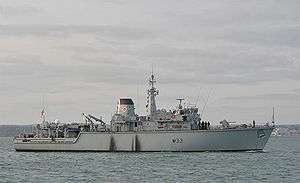HMS Brocklesby (M33)
HMS Brocklesby is a Hunt-class mine countermeasures vessel of the British Royal Navy.
 HMS Brocklesby in Portsmouth, October 2008 | |
| History | |
|---|---|
| Name: | HMS Brocklesby |
| Operator: | Royal Navy |
| Builder: | Vosper Thornycroft |
| Launched: | 12 January 1982 |
| Sponsored by: | Viscountess Trenchard, the wife of Viscount Trenchard MC, then Minister of State for Defence Procurement |
| Completed: | 25 October 1982 |
| Commissioned: | 3 February 1983 |
| Homeport: | HMS Jufair, Bahrain |
| Identification: |
|
| Honours and awards: | Al Faw – 2003 |
| Status: | in active service |
| General characteristics | |
| Class and type: | Hunt-class mine countermeasures vessel |
| Displacement: | 750 t (740 long tons; 830 short tons)[1] |
| Length: | 60 m (196 ft 10 in) |
| Beam: | 9.8 m (32 ft 2 in) |
| Draught: | 2.2 m (7 ft 3 in) |
| Propulsion: | 2 × Caterpillar C32, 2 × FPP – 757 kW (1,015 hp) |
| Speed: | 15 kn (28 km/h; 17 mph) |
| Boats & landing craft carried: | 2 × MIB Diving Support Boats |
| Complement: | 45 (6 officers & 39 ratings) |
| Sensors and processing systems: | Sonar Type 2193 |
| Electronic warfare & decoys: |
|
| Armament: |
|
Brocklesby is now permanently based in Bahrain at HMS Jufair as part of four minehunters of 9th Mine Countermeasures Squadron[2] supported by a Royal Fleet Auxiliary Bay Class on Operation Kipion.
Operational history
Cherbourg incident
In 1993 she became involved in the Cherbourg incident, when Brocklesby challenged the French trawler La Calypso in the Channel Islands waters.[3]
2003 Invasion of Iraq
She gained a battle honour when she was among the first coalition ships into Umm Qasr during the 2003 invasion of Iraq. She was part of a group of mine countermeasure vessels that cleared a mined channel into the port, enabling access to it by sea.[4]
2011 Libya operations
In 2011 she took part in surveillance and embargo operations off the coast of Libya alongside HMS Liverpool, as part of Operation Ellamy, the UK's contribution to Operation Unified Protector.[5] In early May 2011, she took part in a mine-clearing operation to secure the waters of Misrata Port, Libya, after mines were dropped by Muammar Gaddafi's forces to prevent aid from being delivered to the besieged city. Brocklesby used her sonar and SeaFox mine disposal system to locate and destroy a mine that was located 1.6 km from the harbour entrance, making the waters safe for aid ships to enter.[6][7]
Brocklesby's commanding officer, Lieutenant Commander Jim Byron DSC, said:
The Royal Navy has always had a great reputation for mine clearance and it is precisely this type of operation that shows the world just how good we are. We are extremely proud that we could use our skills and knowledge to open that port and allow humanitarian aid back into Libya where it is so desperately needed. Without this capability there could have been hundreds of lives lost through the detonation of that mine.
— Captain Byron, Royal Navy interview[7]
Brocklesby returned to Portsmouth on 5 July 2011 flying a special version of the Jolly Roger, indicating the successful destruction of a sea-mine.[7]
Exercise Joint Warrior 2013
In October 2013 she participated in Exercise Joint Warrior.[8]
Op Kipion 2018-2020
During 2018 HMS Brocklesby departed the UK's waters and transited to the Middle East as part of the British commitment to promoting stability in the region. Op Kipion saw four British mine hunters, as well as other warships, spend approximately two years forward deployed. Brocklesby's move to the Middle East saw her take responsibility from HMS Middleton, subsequently allowing Middleton to transit back to the UK.
References
- "Hunt Class Mine Countermeasures Vessels - Specifications". GlobalSecurity.org. 11 July 2011. Retrieved 14 March 2019.
- "RFA Cardigan Bay's winter in the Gulf". www.royalnavy.mod.uk. Retrieved 23 April 2020.
- Arlidge, John (29 March 1993). "French fishermen burn patrol boat's ensign: Minister warns Navy will get tough after two new humiliations in fishing rights dispute". The Independent. Retrieved 14 March 2019.
- "History of HMS Brocklesby". Royal Navy. Archived from the original on 8 December 2009. Retrieved 14 March 2019.
- "Libya: RAF Tornados destroy seven Libyan tanks". BBC News. 9 April 2011. Retrieved 14 March 2019.
- Norton-Taylor, Richard (4 May 2011). "Libyan conflict enters psychological stage". The Guardian. Retrieved 14 March 2019.
- Ministry of Defence (5 July 2011). "HMS Brocklesby returns from Libya mission". GOV.UK. Retrieved 14 March 2019.
- "Scotland Set To Host Exercise Joint Warrior". Royal Navy. 2 October 2013. Archived from the original on 4 October 2013. Retrieved 14 March 2019.